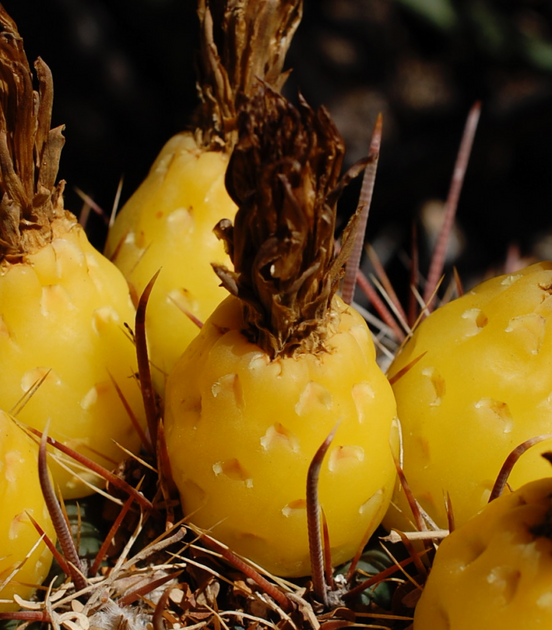Other names: Fishhook Barrel Cactus, Candy Barrel Cactus, Compass Barrel Cactus, Biznaga de agua, Siml (Seri), chiávul (O’Odham)
Edible parts: Fruit, seeds, flower buds, inner flesh.
Season of Harvest: Buds are harvested in the early to mid summer. Fruits are harvested from late November to March. Flesh is harvested at any time. The roots are harvested once cacti have fallen after storms.
———————————————————————————————-
Join me for my 2024 Intro to Foraging course in the Sonoran Desert!
Beginning March 16
———————————————————————————————-
Processing & Preparation:
Flower Buds: The buds can be a challenge to harvest. I have used flathead screwdrivers or tongs (which I’ll have along for prickly pear harvest anyway) to pop them off. Gather no more than 10% from an area. That should leave you plenty to harvest. Collect into a basket or paper bag, even a plastic bucket. The buds are not very delicate, but more so than the fruit so take care not to bruise them while harvesting. The buds are not a ready-to-eat wild food. They’ll take some time and effort to process. Our favorite method is brining or pickling. You can do this a couple of ways. Using vinegar the contents are cooked in a canning pot. If we use salt (with perhaps a bit of vinegar) we can use fermentation from the ambient microbes to allow for perservation. We’ve done both hot canning where we cook the fruit, and “cold processing” where the salt and lactic acid from the microbes do all the “cooking.” You may want to experiment to see which suits your tastes best. Keep in mind that the cooking method will render a softer barrel cactus bud, while the cold method will keep them crisper and firmer. Another decision you’ll have to make is how you’ll want to flavor them. Similar to olive brining, you can impart a certain flavor by adding spices such as onion, garlic, bay leaf, oregano, thyme, tomatillos, mustard seed, sugar, honey, fresh cilantro, wild oregano, oreganillo, chile, etc. You may choose to use what’s available in your garden at the time along with what you’ve harvested and stored from the previous season. A trip to the farmer’s market may give you some ideas, also. Begin by sorting your buds. You can brine them whole, or choose to slice them lengthwise or crosswise. Those left whole will take longer to finish brining, but you may want to leave them whole for their appearance as a garnish for your wild foods feast. Slicing lengthwise may allow for the buds to come loose. They are made up of overlapping sheets similar to an artichoke (a flower bud itself). You may want to get all your spices ready so you can layer them in with the flower buds. Alternately, you can add it all at once and shake it up with the canning lid screwed on. Add enough liquid to cover all the ingredients. If you like a milder flavor you can cut the vinegar with 25% water, but no less. For the salt method use 2 tablespoons salt per quart. Add all desired flavorings and shake well. Then leave the open jar on your countertop or any warm space with a cheese cloth covering the opening for about 4 days. You should now begin to see some bubbles appearing at the top which weren’t there before. Loosely cover the jar and set aside in a cool, dark place. The rest of the pickling/fermenting process should take about 2-4 weeks. Store covered in the refrigerator.
Pickled Barrel Cactus Flower Buds
Fruit/Seeds: Since the fruits are mucilaginous, as are the moistened seeds within, you are going to slice the fruits in half to let some moisture dry out before continuing to process. First chop off the remnants of the flower (tepals) and the tough flesh just below. Now slice the fruit in half lengthwise opening it like a book. Test to see how much moisture is in the seeds. Later-season harvests may dry out considerably rendering this step unnecessary. If considerably moist, place the fruits seeds up in a flat basket, tray, or pan, and allow to air dry for 1-3 days depending on moisture conditions. If you try to remove the seeds right away when moist, you may find it too sticky and unwieldy to deal with. Once the seeds have dried sufficiently to work with, begin scooping out the seeds with a metal spoon into a dry cast iron pan. The seeds may still be sticky. Place the pan on the stove with the heat on low and stir the seeds around every few minutes. If you hear any “pops” then the flame is too high. You only want to lightly toast the seeds while evaporating the excess moisture. You should see steam rising up from the pan while the moisture is evaporating. This may take 10-20 minutes. Once cool, add the seeds to a glass jar and store covered in the dark, or in the refrigerator/freezer. You can add the seeds to: breads, hot cereal, granola, soups, smoothies, squash dishes, salad dressings, over sauteéd greens, use your imagination! You can also grind the seeds into a flour (see Recipe below). Alternately, you can dry the seeds in the sun (1-2 days, weather permitting) which may cause less damage to the oils present in the seeds, but will not impart flavor to the rather bland seeds as toasting does.
Now you have the fresh fruit halves to process. Due to their fibrous nature you will likely want to cut them into smaller pieces before consuming. One of my favorite ways to prepare them is as a chutney.
Barrel Cactus Chutney (For 1 qt of chopped fruit)
Barrel Cactus Chutney
Cinnamon 1 Tbl
Ginger 1Tbl
Clove 1 tsp
Honey 1 cup
Raisins 1/2 cup
Salt 1/2 tsp
Spicy Version
Jalapeños or Chilitepin to taste
Garlic 2-8 cloves
Apple Cider Vinegar 2 Tbl
Organic Sugar 1 Tbl
Extra Virgin Olive oil 1-2 Tbl *optional
Salt 1 tsp
Chopping Barrel Cactus
First chop the cactus flesh into 1/4” square chunks, or strips about 1/4-1/8” wide. No matter how long you cook them the chunks won’t break down, they just get softer. I suggest starting with enough water to cover the fruit in a pot, and set to boil. Once boiling, reduce the heat to a simmer and leave the pot covered. At this point you can add your spices (cinnamon, ginger, & clove, or chile), raisins, salt, and vinegar. Cook the fruit at least 60 minutes to soften the flesh before adding the remaining ingredients. I like to add the honey toward the end so it’s not exposed to high heat for too long. The sugar can be added at any time. The chutney is done when you like the consistency of the fruit. Remember, it will get soft, but will not become creamy. Add the garlic and olive oil once the heat has been turned off. The medicinal qualities of the garlic will be greatest if done this way. If you are making a large batch, pour the hot chutney into canning jars and screw the lid on tight. For at-home use, this may suffice, but to be sure your chutney is shelf stable boil in a water bath for 15-25 minutes depending on your elevation (higher elevation, longer time).
Cooking Barrel Cactus in Simple Syrup
Candied Barrel Cactus Fruit
Barrel Cactus fruit sliced in 1/4” wide strips
Honey – or – Sugar made into Simple Syrup
Cinnamon, Ginger, Fennel to taste
This is really simple. Pre-heat the oven to 325F. Dip the fruit slices in the honey or simple syrup (with added spices if you prefer), and place on a baking sheet. Place in the oven and bake until just before carmelizing (15-25 minutes). You will notice that tougher pieces come out less flavorful, whereas the more ripe fruit really soaks up the honey or syrup and has a chewy texture when finished. Allow to cool and store in glass containers. Once dried, we have found barrel cactus to be quite tough even if reconstituted. Therefore, we recommend fresh fruit preparations.
Candied Barrel Cactus Fruit
Acorn/Barrel Cactus Seed Bread
1 1/2 cup Gluten-free All Purpose flour (Bob’s Red Mill)
1 cup Roasted Acorn flour
1/2 cup Toasted Barrel Cactus Seed flour
1/2 cup Extra Virgin Coconut Oil
2 large free-range eggs
1 1/4 cup Coconut or Almond Milk
1 Tbl Baking Powder
1/4 tsp sea salt
*drizzle olive oil over the bread before placing in the oven.
Preheat oven to 350 F. Bring the coconut oil to a liquid temperature. Blend all dry ingredients. Combine with all remaining ingredients. Blend well and quickly. Place into a 9 x 9″ greased baking pan. It may take some molding with your hands to get the batter evenly displaced throughout the pan. Place the pan in the oven for 25-30 minutes or until a toothpick comes out clean.
Toasted Barrel Cactus Seed Flour
Serve hot with organic butter. For leftover bread, toast in a cast iron pan with butter before serving. Enjoy!
Flesh: The flesh is traditionally consumed as a means of hydration by the Seri, or Cómcaac, people of coastal Sonora. Below is a photo of the freshly prepared siml. When crossing long distances of desert which contain no natural water source, a Seri will be looking for a Barrel Cactus when he gets thirsty. They have existed across some of the hottest and driest areas of the Sonoran desert from Puerto Peñasco to Guaymas, Sonora. Most of this area is dry for 90% of the year. When they feel the need to rehydrate they will first gather a few armloads of thin, light, highly flammable brush to stack around the cactus. Once lit, this quick, high temperature brush fire will eliminate most of the spines to allow for easy handling. Once cooled enough the cactus is then toppled over to uproot it. Then a circumferential cut is made to half the Barrel Cactus. The flesh found within is reminiscent of a jícama, apple, and a marshmallow combined. The flavor is slightly bitter and soapy, but full of fresh moisture. My Seri friends eat it with a bit of sugar/salt mixture (as they do skinned Cholla fruit). Some unaccustomed stomachs may find it a bit nauseating after several bites (due to oxalic acid?), but I have seen young Seri boys going back for piece after piece all day long as if it were chocolate cake! The Gila River Pima once cooked slices of it in water with mesquite pods, or later sugar. It was this cactus flesh that gave it the name Candy Barrel Cactus as it was once cooked with a thick sugar syrup and made into chewable cactus candy sold all over the southwest to tourists and locals alike. Yet another traditional method (Tohono O’Odham) was to cook the slices in saguaro or organ pipe fruit juice for some time then pull them out to dry rendering them as a sweet preserve. Roots: The roots can be used similar to roots of the Jumping Cholla (Cylindropuntia fulgida) cactus. However, I don’t recommend digging them up off a live plant. When storms and other factors contribute to a downed barrel cactus there will be some exposed roots which will dry out and die in short time. If you happen to be in the right place at the right time you can cut the roots back from the base of the cactus. Then chop and dry to put aside for tea. Like Cholla root, you can use it in tea form (decoction) to help with urinary tract irritations, tendency to form stones, or genito-urinary tract infections.
Eating the Inside of the Barrel Cactus


